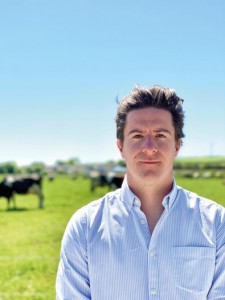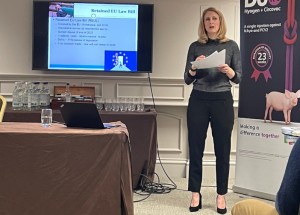Pressure is coming down the chain from retailers for pork producers to record their carbon footprint, alongside moves to harmonise carbon labelling. Vicky Lewis looks at what farmers need to know and do to comply.
The pig sector has, on the whole, got a good story to tell when it comes to its carbon footprint – and now there is increasing pressure to demonstrate it. The carbon footprint of food is identified as the greenhouse gas (GHG) emissions produced through a product’s journey – from growing to disposal, including rearing, farming, processing, storing, transporting and cooking. A UN-backed 2021 study showed that food systems are responsible for over a third of global GHG emissions, and the heat is on the industry to take action. This is currently reflected in a growing focus by retailers on on-farm carbon footprints, according to NPA chief executive Lizzie Wilson. Retailers are facing pressure to deliver on their Scope 3 emissions commitment, which include all indirect emissions, much of which in the food supply chain come from farms that supply them.
Andrew Opie, director of food and sustainability at the British Retail Consortium, said: “Every retailer knows that they must take action to reduce carbon emissions in the supply chain – particularly for carbon-intensive areas like livestock farming.”
In the short term, this means producers are increasingly being asked to demonstrate their own carbon footprint, while environmental labelling requirements are set to be stepped up. Defra announced in April that by 2024, a ‘harmonised methodology’ will be set out supporting farmers to measure emissions. This was partly a recognition that ‘inconsistencies’ in current recording methodologies has ‘led to low confidence from the industry and low uptake’. By setting out how farmers will be supported to measure their emissions, Defra said it can help the agricultural sector reduce emissions across the supply chain, including from livestock, nutrient management, and farm equipment. There are already various and, in some cases, very different, schemes and labels out there. The Institute of Grocery Distribution (IGD) has been given the task of developing a single, harmonised label to simplify the system for consumers and enable them to make more informed decisions, while also helping businesses source products more sustainably. This will take the form of a traffic light system for comparison or a display of foods carbon dioxide equivalent in grams/kilograms. It ties in with the Government’s 2022 Food Strategy commitment to develop a mandatory methodology for businesses using ‘eco labels’ or making sustainability claims on food products.
Where to start?
Mrs Wilson explained that there are a wide range of carbon calculators available and said individual producers will need to assess which works best for their business, and fits in with what the supply chain is asking. “Once you have churned out that figure, that is your benchmark,” she said. “You can use your carbon calculator to identify hotspots, make improvements and put together a plan of action.” AHDB has published a guide for selecting a calculator, including the questions producers should ask to determine whether the tool is right for them and their farm, and the technical questions to ask to ensure the best possible data is gained. You can find more information here.
NFU has released similar support, and, with over 60 different calculators available, fully reviewed three calculators that are most applicable to NFU members, focusing on usability, coverage, scientific robustness and practicality. Many producers are already measuring their footprint. Pilgrim’s UK has a comprehensive plan in place and is using an assessment tool to calculate and plan from. Matt Dight, head of sustainability, said the company reviewed 13 before choosing Sustain from AB Agri’s data and technology division. “It’s worth noting that many carbon assessment tools are geared towards indoor pig production and that there are large discrepancies between the results of many tools,” he said. “The key is to ensure assessment methods are consistent.”

Retail giant Tesco agreed that a standardised industry approach is necessary. A spokesperson said: “In order to help our customers make informed choices when they shop with us, we believe that having a clear and coherent industry approach to explaining the environmental impact of products is important.”
Mr Dight explained that carbon labelling in isolation is unlikely to significantly impact the environment without wider, joined up thinking going on around it. “This should be part of a bigger conversation around the carbon impact of the food we eat,” he said. “For example, carbon labelling won’t reflect other environmental and social sustainability aspects, such as whether a piece of pork has been produced using higher welfare techniques or has formed part of a mixed rotation. We also need to focus our efforts on educating consumers about the provenance of the products they consume – how the meat they’ve purchased was raised and how the farmer’s livestock methods are contributing to carbon reduction initiatives more broadly.”
He also warned that the system in place needs to accurately reflect current conditions on farms, not historic data.“At the moment, there is a real risk that mandatory carbon labelling could be brought in using secondary, regional GHG emissions data,” Mr Dight added. “In that case, all the good work undertaken to reduce emissions may not even be considered and historic data – from as far back as 2006 – could be used as ‘representative’ of pork production.
“A bigger conversation about providing the right information to consumers needs to be had before committing to any mandatory labelling schemes.”
Reducing your carbon footprint?

Mrs Wilson said there was plenty producers could do to reduce their carbon footprint, highlighting improving efficiency, particularly feed conversion, and focusing on where feed is sourced from. “We’re heading very quickly towards sustainably sourced soya and more and more producers are starting to use substitutes, such as growing peas and beans for protein,” she told an NPA Regional meeting in April. “Renewables can also contribute, wherever you can manage to plant them, while land-locking that carbon via trees and hedgerows helps.”
Mr Dight agreed that optimising diets should be a priority focus area. “Lowering GHG emissions and farm performance go hand-in-hand,” he said. “Deploying methods to boost the health of pig herds, improving mortality and feed conversion rates and improving energy and resource efficiency are all vital in reducing emissions. It also results in less waste and more profit.”
He explained that feed suppliers have a plan to transition to verified deforestation and conversion-free ingredients. Pilgrim’s has reduced its soya usage and ensures that the soya is traceable and responsibly sourced. In a 2020 publication, the US Department of Agriculture estimated that 75% of the world’s soya output is used as feed for animals and the increasing global demand for meat has seen destruction of the Amazon rainforest and savannahs. In November, 38 leading UK food companies and soya suppliers announced a landmark set of actions to work together towards ensuring all soy used in animal feed in the UK is deforestation free.
The organisations include Pilgrim’s and fellow pork processors, Cranswick, as well as a number of leading retailers, representing nearly 60% of the UK’s soy consumption. Cargill Animal Nutrition UK recently announced it has introduced its Triple S soya, sourced from areas in Brazil, Argentina and Paraguay that are guaranteed deforestation-free since 2008, as a replacement for all soya sources in its pre-starter and starter pig and poultry diets.
Consumer views
A 2020 Carbon Trust-commissioned research survey conducted with over 10,000 consumers across France, Germany, Italy, the Netherlands, Spain, Sweden, the UK and the US saw two-thirds of participants supporting carbon labelling. 64% said they are more likely to think positively about a brand that could demonstrate it had lowered the carbon footprint of its products, suggesting that partaking in carbon labelling could enhance a company’s reputation and market share. Mrs Wilson added: “We do have a really good story to tell – we just don’t have a lot of data, so the more producers can shout about it, the better.”
Help for farmers
Grants are available to help producers in England improve efficiency and reduce carbon footprint, including:
- Farm Equipment and Technology Fund (FETF) – grants towards new technology or equipment to boost productivity and slurry management and improve pig health and welfare.
- Farming Transformation Fund (FTF) – bigger grants for capital items to improve productivity, including through robotic or autonomous equipment.
- Slurry Infrastructure Grant Scheme – grants to support slurry storage.
- Countryside Stewardship – financial incentives for farmers to improve the environment.
- Keep an eye on the Pig World and NPA websites for details and application windows.




